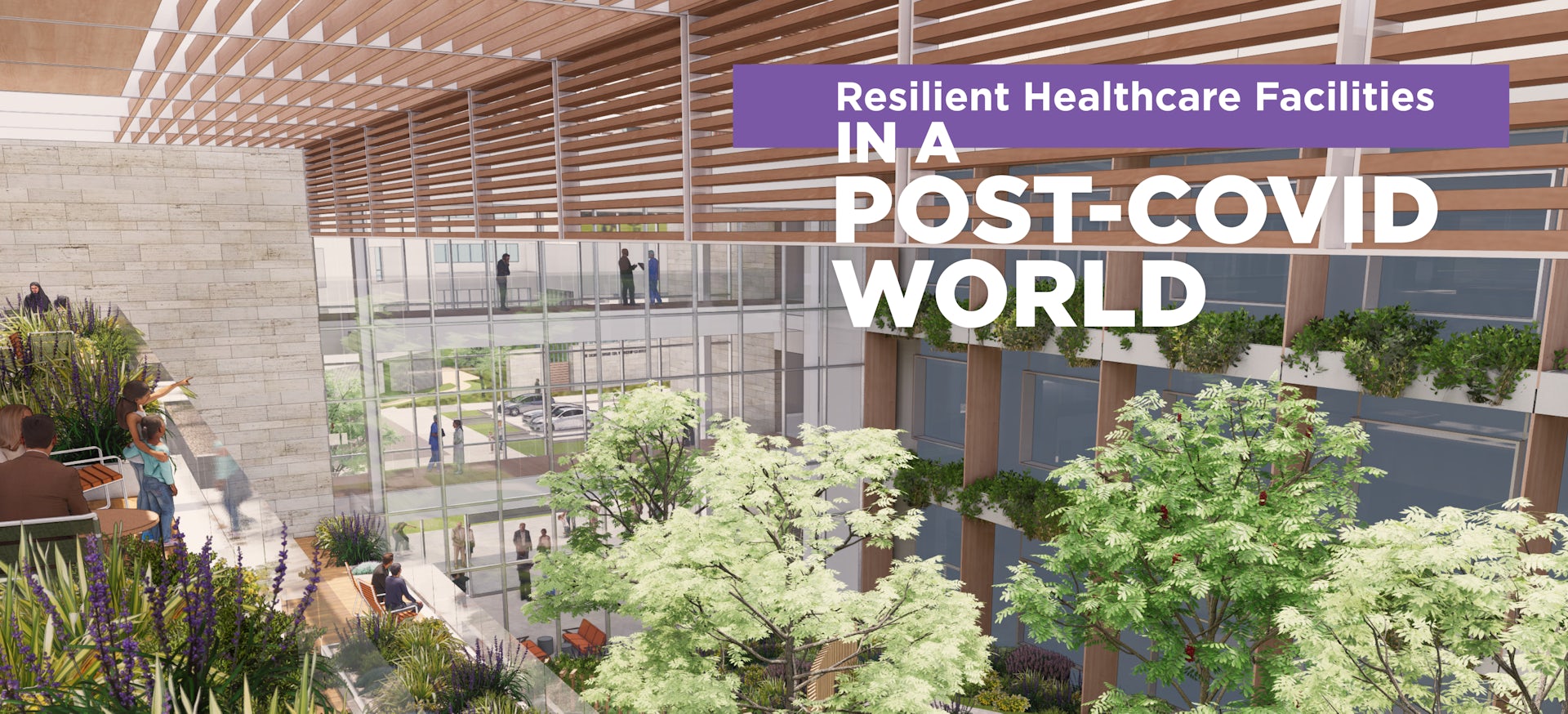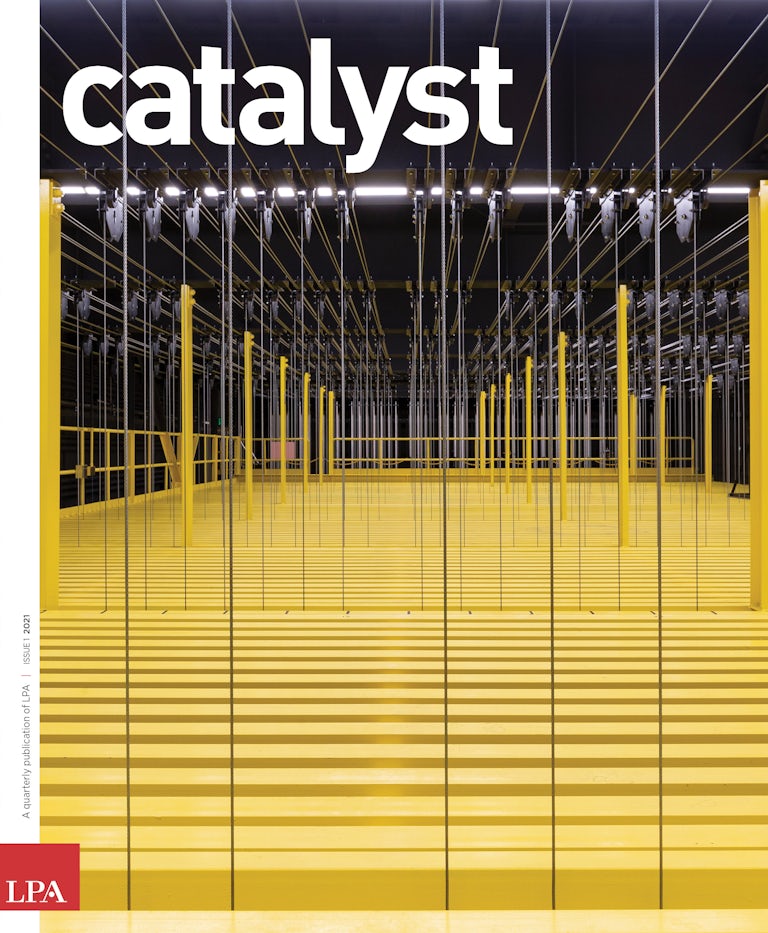Priorities in healthcare can shift instantly, as the world has seen during the coronavirus pandemic. How can healthcare providers prepare their facilities for the inevitable change that is coming in weeks, years or decades? More than ever, future-proofing projects is key to creating facilities that maximize adaptability and flexibility, recognizing the potential for fundamental changes ahead.
Even before the pandemic, the industry was in the midst of transformation. “Now, care providers make money by keeping patients out of hospital beds, not in hospital beds, and administrators must adapt to this new reality,” says LPA Director of Healthcare Muhsin Lihony.
Resilient Healthcare Facilities in a Post-COVID World
The pandemic has put the spotlight on the need for flexible, easily adaptable care centers able to respond quickly to changing community needs. Core design strategies can keep a facility relevant for generations.

Providers are facing a dramatic move toward virtual visits and telemedicine, with Medicaid and Medicare adjusting reimbursement policies to include telehealth and remote access. The number of telemedicine interactions will top 1 billion in the United States this year, according to Forrester, a research and consulting firm based in Cambridge, Massachusetts. The fundamental nature of healthcare has shifted to a focus on individualized care.
For any healthcare provider, it is essential to develop strategies for creating facilities that are adaptable and resilient to the changing times. At every step of the planning and building process, opportunities exist to develop facilities that will work more efficiently and last longer. A few core principles can guide the process.
Plan for Future Need
Early in the planning process, LPA Regional Managing Director of Healthcare Greg Schneekluth often asks participants to envision an extra seat at the table, representing a future need. Maybe it is an additional shelled space for a specialized piece of equipment or a full floor for additional beds for alternative patient care. “How does the design create flexibility to meet the needs of that missing stakeholder?” Schneekluth asks the group.
One way to approach the issue is to make expansion more seamless. For example, instead of designing a hospital in a restrictive grid with multiple columns, an open, spokes-style plan might allow outward expansion with minimal extra construction. “If you’re painting a floor, you don’t paint yourself into a corner,” Schneekluth says. “It’s the same way with expansion-friendly facility design.”
Relying on research helps us to design facilities that can adapt to the disruptions that will happen in the healthcare industry in the next 10, 20 and even 50 years.
Put Researchers to Work
Ongoing research into the needs and expectations of patients and medical professionals is “the next best thing to a crystal ball,” Lihony says. LPAred, the firm’s in-house research team, helps create actionable data on design choices and the real interests of users and the community.
“Relying on research helps us to design facilities that can adapt to the disruptions that will happen in the healthcare industry in the next 10, 20 and even 50 years,” Lihony says.
Consider Alternative Design Systems
The coronavirus pandemic has highlighted the need for speedy conversions, says Rick Wood, LPA Director of Healthcare. “You may have a low-acuity facility that suddenly needs to take COVID-19 patients who need more oxygen, more power, more ventilators,” Wood says. “To move quickly, the facility must have adaptability built-in.”
Modular systems are one solution. They provide a simple way to expand flexibility while lowering costs and speeding the construction process. One example: modular ceiling systems with specialized medical gas and air-conditioning units that can be easily swapped as needs change for treatment rooms and ICUs. Modular systems can also be used for restrooms, storage rooms and additional exam rooms.
“The quality of modular construction is high, and it makes sense to use it in highly sensitive healthcare facilities and spaces,” Lihony says.

Maximize Outdoor Connections
Links to the outside world will become increasingly important in the years ahead. “We’re really looking for ways to develop courtyard spaces in hospitals, which are too often a labyrinth of maze-like corridors,” Wood says.
Garden areas, respite zones, outdoor consultation spaces and open-air waiting areas will expand the usable space of a facility and create value. Outdoor spaces create a meaningful benefit for both patients and staff, while contributing to the overall wellness of everyone involved.
“That’s what we do best at LPA,” says Marcus Thorne, a Senior Medical Planner. “We utilize the outdoor spaces as program space instead of just an afterthought.”

Embrace the Environment
A facility filled with natural light and fresh air is more efficient and more sustainable and can improve the health of the people who use the facility. A close focus on building orientation and passive systems allows healthcare facilities to save money on power, achieve green certification and limit the impact of future energy crises.
Environmental stewardship provides many benefits. Sustainable materials often require less maintenance and will remain available for reuse. The expense of constructing a facility makes up only about 10 percent of its life-cycle cost, Lihony says. “Sustainable design helps lower expenses for decades, and lowering cost is an important part of future-proofing,” he says.


Establish the Brand
As roles shift, facilities will increasingly represent the brand and mission of the provider. A welcoming environment with a seamless, touch-free registration process will help define the relationship with the client over many years. “The branding experience will be very much a part of the mix of healthcare design,” says LPA Designer Carrie Johansen. “From the moment someone enters a building, the facility speaks to them about the provider’s values and how they are going to experience the whole process.”
Space once used as a waiting room will need to play many roles in the life cycle of a facility. Connections to nature, materials, daylight and wayfinding can help bring the brand to life and extend the facility’s effectiveness.

Create More Adaptable Patient Rooms
Healthcare facilities are just beginning the move to more acuity-adaptable rooms, allowing them to use a room for patients regardless of how ill they are. Codes are changing to reflect this new reality. Universal patient beds will help facilities nimbly shift with market needs, expanding care centers’ lives.
“It gives you that flexibility in the future to make that room more of an ICU or a medical/surgery unit,” Thorne says. “It might mean that a hospital won’t need to build a new wing to accommodate different uses in the future.”

Rethink Administrative Spaces
It is time for staff workspaces to be upgraded. Many ideas of the efficient corporate workplace can help create work environments that spur collaboration and innovation among healthcare professionals. Spaces will need to be flexible in recognition of changing work styles.
Offices are already being replaced by co-labs and “team care areas.” New designs will improve workflow and help to attract and retain top professionals. “There are real advantages if we can shift to more beds and less administrative,” Johansen says.

Learn from the Pandemic
The coronavirus pandemic is highlighting a greater need for infection control, telemedicine and social distancing. To keep patients from infecting one another, new facilities should include more exam rooms and fewer waiting rooms. Low-slung buildings of two or three stories will displace towers, as healthcare systems focus on outpatient services. Future design must acknowledge fundamental changes in facilities’ functional requirements.
“We cannot continue to do things the same way,” Schneekluth says. “But the goal remains to build facilities that can adjust to new needs and future crises, since healthcare is certain to face both.”















